Puget Sound Naval Shipyard | |
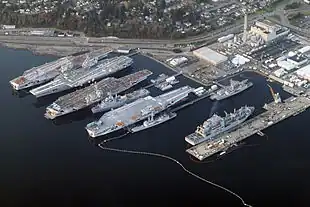 Four decommissioned aircraft carriers docked at the shipyard. From left: Independence, Kitty Hawk, Constellation and Ranger. | |
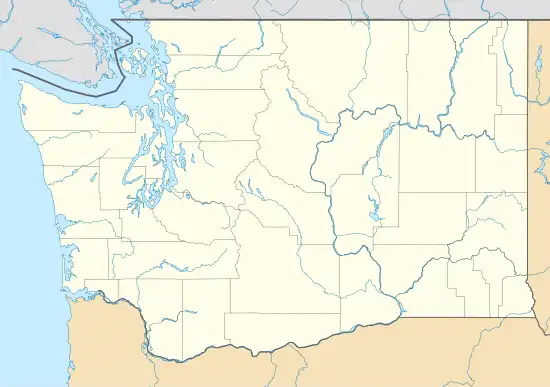 | |
| Location | N shore of Sinclair Inlet, Bremerton, WA |
|---|---|
| Coordinates | 47°33′31″N 122°38′39″W / 47.5585°N 122.6442°W |
| Architect | US Navy |
| NRHP reference No. | 92001883 |
| Significant dates | |
| Added to NRHP | 27 August 1992[1] |
| Designated NHLD | 27 August 1992[2] |
| Puget Sound Naval Shipyard and Intermediate Maintenance Facility | |
|---|---|
| Puget Sound, Washington | |
| Type | Shipyard |
| Site information | |
| Controlled by | United States Navy |
| Site history | |
| Built | 1891 |
| In use | 1891–present |
| Garrison information | |
| Current commander | CAPT JD Crinklaw (2023 - present) |
Puget Sound Naval Shipyard, officially Puget Sound Naval Shipyard and Intermediate Maintenance Facility (PSNS & IMF), is a United States Navy shipyard covering 179 acres (0.7 km2) on Puget Sound at Bremerton, Washington in uninterrupted use since its establishment in 1891; it has also been known as Navy Yard Puget Sound, Bremerton Navy Yard, and the Bremerton Naval Complex.
It is bordered on the south by Sinclair Inlet, on the west by the Bremerton Annex of Naval Base Kitsap, and on the north and east by the city of Bremerton, Washington. It is the Pacific Northwest's largest naval shore facility and one of Washington state's largest industrial installations. PSNS & IMF provides the Navy with maintenance, modernization, and technical and logistics support, and employs 14,000 people.[3]
History

Puget Sound Naval Shipyard was established in 1891 as a Naval Station and was designated Navy Yard Puget Sound in 1901. During World War I, the Navy Yard constructed ships, including 25 subchasers, seven submarines, two minesweepers, seven seagoing tugs, and two ammunition ships, as well as 1,700 small boats. During World War II, the shipyard's primary effort was the repair of battle damage to ships of the U.S. fleet and those of its allies.
Following World War II, Navy Yard Puget Sound was designated Puget Sound Naval Shipyard. It engaged in an extensive program of modernizing carriers, including converting conventional flight decks to angle decks. During the Korean War, the shipyard was engaged in the activation of ships. In the late 1950s, it entered an era of new construction with the building of a new class of guided missile frigates. In 1965, USS Sculpin (SSN 590) became the first nuclear-powered submarine to be maintained at PSNS. The shipyard was designated a National Historic Landmark in 1992.[2][4] The historic district includes 22 contributing buildings and 42 contributing structures, as well as 49 non-contributing buildings, structures, and objects.[4]
Installations
Perhaps the most visible feature of the shipyard is its green hammerhead crane, built in 1933. The PSNS hammerhead crane is 250 feet (76 m) tall and 80 feet (24 m) wide with a lifting capacity of 250 tons.[5]
Historic districts
The Puget Sound Naval Shipyard contains five historic districts:
- Officers' Row Historic District;
- Puget Sound Radio Station Historic District;
- Hospital Reservation Historic District;
- Puget Sound Naval Shipyard Historic District; and
- Marine Reservation Historic District.
These five units are a comprehensive representation of the historic features of the naval shipyard.
Dry Docks and Slipways
| Dock No. | Material of which dock is constructed | Length | Width | Depth | Date Completed | Source |
|---|---|---|---|---|---|---|
| 1 | Concrete | 638 feet 11 inches (194.74 m) | 108 feet (33 m) | 30 feet 2 inches (9.19 m) | 1896[6] | [7] |
| 2 | Concrete and granite | 867 feet (264 m) | 145 feet (44 m) | 38 feet 2 inches (11.63 m) | 1911 | |
| 3 | Concrete | 926 feet 8 inches (282.45 m) | 130 feet (40 m) | 23 feet 8 inches (7.21 m) | 1919 | |
| 4 | Concrete | 997 feet 10 inches (304.14 m) | 147 feet (45 m) | 45 feet 2 inches (13.77 m) | 1940 | |
| 5 | Concrete | 1,030 feet 6 inches (314.10 m) | 147 feet (45 m) | 45 feet 2 inches (13.77 m) | 1941 | |
| 6 | Concrete | 1,151 feet 11 inches (351.10 m) | 180 feet (55 m) | 53 feet 2 inches (16.21 m) | 1962 |
| January 1, 1946 | |||
|---|---|---|---|
| Shipbuilding ways | Width | Length | Source |
| 1 and 2 | 109 feet (33 m) | 400 feet (120 m) | [8] |
| 3 and 4 | 109 feet (33 m) | 400 feet (120 m) | |
Operations
Shipbuilding
- Heavy cruisers
- 1 of 6 Northampton-class (built July 1928 - September 1930)
- 1 of 7 New Orleans-class (September 1930 - December 1933)
- Destroyers
- 1 of 8 Farragut-class (built December 1932 - October 1934)
- 2 of 18 Mahan-class (August 1934 - December 1935)
- 2 of 8 Bagley-class (July 1935 - May 1937)
- Patterson
- Jarvis
- 1 of 8 Benham-class (March 1937 - April 1939)
- 1 of 30 Benson-class (January 1939 - May 1940)
- 1 of 66 Gleaves-class (July 1939 - May 1940)
- 8 of 175 Fletcher-class (June 1941 - September 1944)
- 8 of 65 Evarts-class destroyer escorts (September 1942 - August 1943)
Ship-Submarine Recycling Program
In 1990 the Navy authorized the Ship-Submarine Recycling Program (SRP) to recycle nuclear-powered ships at PSNS. Approximately 25% of the shipyard's workload involves inactivation, reactor compartment disposal, and recycling of ships. It has pioneered an environmentally safe method of deactivating and recycling nuclear-powered ships. This process places the U.S. Navy in the role of being the world's only organization to design, build, operate, and recycle nuclear-powered ships. On 15 May 2003 PSNS and IMF were consolidated into what is now known as PSNS & IMF.
PSNS is the only U.S. facility certified to recycle nuclear ships. During all this period Puget Sound Naval Shipyard has scrapped more than 125 submarines and some cruisers.[9]
Reserve fleet
The shipyard contains a portion of the United States Navy reserve fleet, a large collection of inactive U.S. Navy vessels.[10] The aircraft carrier USS Kitty Hawk (CV-63) was mothballed there until May 2022 when it was removed for scrapping.[11]
Environmental issues
Gorst Creek Ravine near Port Orchard, Washington was a hazardous waste dump for the Navy's shipyard waste between 1969 and 1970, when the site was not permitted by local authorities to take waste.[12] After several collapses since 1997 the landfill could blow out Highway 3. The landfill is an "ongoing source of pesticides, polychlorinated biphenyls and metals flowing downstream with the potential to affect groundwater wells, sport fisheries and the Suquamish Tribe's fish hatchery.[12] In October 2014, the US EPA ordered the Navy to fix the problems.[13]
Gallery
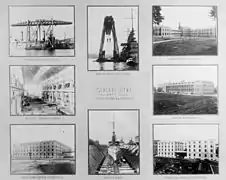 Navy Yard views in 1910
Navy Yard views in 1910 Puget Sound Navy Yard in 1913
Puget Sound Navy Yard in 1913%252C_USS_Lexington_(CV-2)_and_USS_Saratoga_(CV-3)_at_the_Puget_Sound_Naval_Shipyard%252C_in_1929_(NNAM.1996.488.001.004).jpg.webp) Aircraft carriers USS Langley (CV-1), USS Saratoga (CV-3), USS Lexington (CV-2) at Puget Sound, 1929
Aircraft carriers USS Langley (CV-1), USS Saratoga (CV-3), USS Lexington (CV-2) at Puget Sound, 1929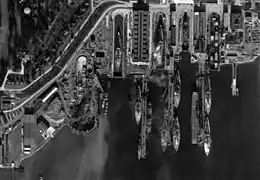 Puget Sound Navy Yard in 1940
Puget Sound Navy Yard in 1940 Franklin D. Roosevelt delivers a radio address (August 12, 1944)
Franklin D. Roosevelt delivers a radio address (August 12, 1944) Mothballed ships in 1974
Mothballed ships in 1974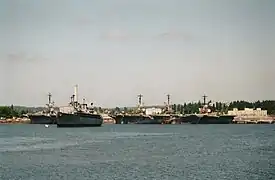 Retired Essex-class carriers in 1989
Retired Essex-class carriers in 1989 The mothball fleet in Puget Sound Naval Shipyard
The mothball fleet in Puget Sound Naval Shipyard Puget Sound Naval Shipyard, as seen from across the water in Port Orchard. The mothballed ships are on the left, and the hammerhead crane is on the right.
Puget Sound Naval Shipyard, as seen from across the water in Port Orchard. The mothballed ships are on the left, and the hammerhead crane is on the right.
See also
Notes
- ↑ "National Register Information System". National Register of Historic Places. National Park Service. 23 January 2007.
- 1 2 "Puget Sound Naval Shipyard". National Historic Landmark summary listing. National Park Service. Archived from the original on 15 April 2008. Retrieved 12 April 2008.
- ↑ Farley, Josh (23 March 2020). "USS Carl Vinson sailor tests positive for novel coronavirus". Kitsap Sun. Archived from the original on 3 April 2020.
- 1 2 Erwin N. Thompson and Ben Levy (20 December 1990). "National Register of Historic Places Registration: Navy Yard Puget Sound / Bremerton Navy Yard; Puget Sound Naval Shipyard" (PDF). National Park Service. Retrieved 3 May 2009.
{{cite journal}}: Cite journal requires|journal=(help) and Accompanying 17 photos, from 1985 and 1991 (3.71 MB) - ↑ Putnam, Mass Communication Specialist 3rd Class Kirk T. (19 July 2009). "Senior Chief Re-enlists on Historic Bremerton Landmark". America's Navy. Archived from the original on 9 July 2017. Retrieved 3 February 2021.
{{cite web}}: CS1 maint: numeric names: authors list (link) - ↑ Reh, Louise (1991). Nipsic to Nimitz. Bremerton, Washington: Puget Sound Navy Museum Foundation. p. 12. ISBN 0-931475-02-3.
- ↑ "Drydocking Facilities Characteristics" (PDF).
- ↑ Gardiner Fassett, Frederick (1948). The Shipbuilding Business in the United States of America. Society of Naval Architects and Marine Engineers. p. 177.
- ↑ "Navy exploring private firms for typically PSNS work". Retrieved 12 August 2016.
- ↑ "Navy Decommissions USS Kitty Hawk". America's Navy. 12 May 2009. Retrieved 15 December 2015.
- ↑ Friedrich, Ed (6 February 2009). "Kitty Hawk Gives Bremerton a Quartet of Vietnam-Era Carriers". Kitsap Sun. Retrieved 15 December 2015.
- 1 2 "EPA to Navy: Fix issues at former dump". Columbian (WA). Associated Press. 16 October 2014. Archived from the original on 1 December 2014. Retrieved 19 November 2014.
- ↑ Dunagan, Christopher. "EPA wants Navy to help fix former dump". Retrieved 10 September 2015.
External links
- Puget Sound Naval Shipyard & Intermediate Maintenance Facility
- Historic American Engineering Record (HAER) documentation, filed under Bremerton, Kitsap County, WA:
- HAER No. WA-116-A, "Puget Sound Naval Shipyard, Pattern Shop", 30 photos, 9 data pages, 3 photo caption pages
- HAER No. WA-116-B, "Puget Sound Naval Shipyard, 1000-Ton Forging Press", 1 photo, 8 data pages, 1 photo caption page
- HAER No. WA-116-C, "Puget Sound Naval Shipyard, Portal Gantry Crane No. 51", 1 photo, 6 data pages, 1 photo caption page
- HAER No. WA-116-D, "Puget Sound Naval Shipyard, Portal Gantry Crane No. 55", 2 photos, 6 data pages, 1 photo caption page
- HAER No. WA-116-E, "Puget Sound Naval Shipyard, Drydock No. 3", 38 photos, 16 data pages, 3 photo caption pages
- HAER No. WA-116-F, "Puget Sound Naval Shipyard, Portal Gantry Crane No. 42", 9 photos, 9 data pages, 1 photo caption page
